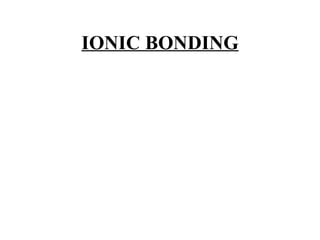Report
Share

More Related Content
What's hot
What's hot (20)
Properties and Formation of Ionic Compounds Powerpoint

Properties and Formation of Ionic Compounds Powerpoint
Chemistry - Chp 7 - Ionic And Metallic Bonding - PowerPoint

Chemistry - Chp 7 - Ionic And Metallic Bonding - PowerPoint
Viewers also liked
Viewers also liked (8)
IB Chemistry on Lewis structure, ionic and covalent bonding

IB Chemistry on Lewis structure, ionic and covalent bonding
Similar to Bonding Notes
Similar to Bonding Notes (20)
General Chemistry at the University of Oklahoma Exam 2

General Chemistry at the University of Oklahoma Exam 2
More from Frederick High School
More from Frederick High School (20)
Bonding Notes
- 3. Ionic Bonding is due to: Ionization Energy (IE) Electronegativity (EN) * Metals have relatively low IEs * Nonmetals have relatively high ENs so . . . Ionic bonding will occur between . . . Metals and Nonmetals
- 6. Writing Ionic Formulas 1 – Determine oxidation number the + or – charge of the ion 2 – Determine the ratio of ions necessary to make the sum of the charges equal to zero 3 – Insert subscripts to indicate the ratio of ions
- 7. Writing Formulas w/Transition Metals Most transition metals have more than one oxidation state Roman numerals in parentheses indicate the oxidation number Example : Fe 2+ iron (II) Fe 3+ iron (III)
- 10. Naming Ionic Compounds 1 – Name the cation first and the anion second 2 – monoatomic cations use the element name 3 – monoatomic anions take their name with –ide for the ending 4 – Transition metals must use Roman numerals to indicate oxidation number 5 – If the compound contains a polyatomic ion, simply name the ion
- 19. ions free to move in metallic bonding ionic bonds are rigid crystals
- 27. mass of element X 100 = percent by mass mass of compound 16.00 g O X 100 = 88.8 % O 18.02 g H 2 O NOTE : If H 2 O is: 11.2 % hydrogen by mass, it should be 88.8 % oxygen by mass.